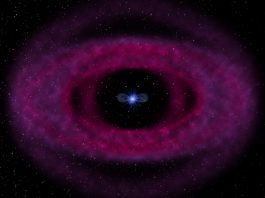A team led by LMU astrophysicist, Basmah Riaz, has detected a special methane compound outside the solar system for the first time, giving new insights into the formation of brown dwarfs.
Brown dwarfs are irregular celestial bodies, occupying an intermediate position between stars and planets. Astrophysicists sometimes refer to them as ‘failed stars’ because they have insufficient mass to burn the hydrogen in their cores to shine like stars.
Proto-brown dwarfs
It is continually debated if the formation of brown dwarfs is simply a small-scale version of the formation of Sun-like stars. Astrophysicists are focusing on the youngest brown dwarfs, also called proto-brown dwarfs. They are only a few thousand years old and are still in the early formation stages. Researchers want to know if the gas and dust in these proto-brown dwarfs resemble the composition of the youngest Sun-like proto-stars.
The primary focus of interest is methane, which is a simple and very stable gas molecule that, once formed, can only be destroyed by high-energy physical processes. It has been found in several extrasolar planets. In the past, methane has played a fundamental role in identifying and studying the properties of the oldest brown dwarfs in our Galaxy, which are several hundred million to billions of years old.
Deuterated methane detected
However, for the first time, a team led by LMU astrophysicist Basmah Riaz, has detected deuterated methane (CH3D) in three proto-brown dwarfs. This was an unexpected result as it is the first clear detection of CH3D outside of the solar system.
Proto-brown dwarfs are very cold and dense objects. This makes them difficult to study for methane signatures in the near infrared. In contrast, they can be readily observed in a millimetre wave range. Contrary to methane that has no spectral signature in the radio domain because of its symmetry, deuterated methane (CH3D) can be observed at millimetre wavelengths.
The first detection of CH3D was considered astonishing because, according to the theories on brown dwarf formation, proto-brown dwarfs are cooler (about 10 Kelvin or less) and denser than proto-stars.
Based on chemical theory, CH3D is preferentially formed when the gas is warm, i.e., at temperatures around 20 to 30 Kelvin. “The measurements imply that at least a significant fraction of the gas in a proto-brown dwarf is warmer than 10 Kelvin, otherwise CH3D should not be there at all,” Riaz explained. The CH3D abundance measurement provides the scientists with a methane abundance estimate.
Sun-like proto-star
It is also unexpected that while there is only one Sun-like proto-star known to date where CH3D has been tentatively detected, the LMU Team has firmly detected CH3D in 3 proto-brown dwarfs. This means that proto-brown dwarfs exhibit a rich warm organic chemistry, and these cool compact astrophysical objects may not be simply a scaled-down replica of proto-stars.
“The methane in the proto-brown dwarfs may or may not survive or retain such high abundance in the oldest brown dwarfs,” concluded co-author Wing-Fai Thi, of the Max Planck Institute for Extra-terrestrial Physics. Therefore, since a warm environment is favourable for forming more complex molecules, proto-brown dwarfs are intriguing objects to search for these molecules in the future.









